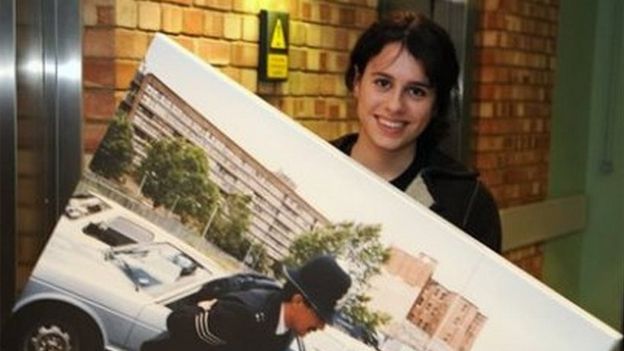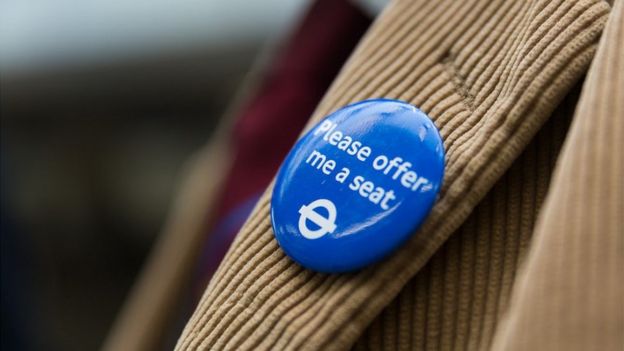From the BBC Disability News site:

Georgia took part in a campaign as a child to show life is not restricted by diabetes
Imagine having to inject yourself thousands of times over the course of your lifetime, but never talking about it to anyone.
Many people live with hidden disabilities - conditions which don't have physical signs but are painful, exhausting and isolating. Sympathy and understanding from others can often be in short supply.
Simon Magnus, Georgia Macqueen Black, Erika North and Natasha Lipman explain what it's like to have a hidden disability, which some of your friends and family may silently be dealing with.
Simon Magnus is dyslexic.
He is the artistic director of arts charity Root Experience.

It's taken me some time to properly "own" my dyslexia. It has been a source of shame and embarrassment for most of my life. In trying to conceal my condition, I have let people think I am lazy and disorganised. The truth is, I really can't get my ideas onto paper, and my fear and anxiety around "being unable to write" has stopped me from achieving things I wanted.
I had a meeting recently and it was going well, then they asked me to do a written evaluation. It made my heart sink. I had to tell them that I couldn't do it. Eyebrows were raised, but I told them about my dyslexia and owned it. The outcome might not have been what I wanted, but it was a huge step for me.
Provision for dyslexic people in everyday life is not available across the board yet, and nor is provision for those of us with anxiety or other hidden disabilities, but I hope they thought about it afterwards and perhaps, in the future, they might consider how they could work with someone like me.
Invisible conditions are just different to how we think the world operates, but the more of us that 'come out' the more we realise how many people live with these experiences and that a simple change in a process can mean all the difference.
Georgia Macqueen Black has Type 1 Diabetes and was diagnosed at the age of 11.
She works for Shape Arts on the National Disability Arts Collection and Archive.

Type 1 Diabetes cannot be seen until I take out my insulin pen and inject myself, but the mechanical parts - blood tests and injections - are only the surface layers of what I have to manage.
Someone may see me inject, but there's an isolating exhaustion I take with me afterwards. There will always be another injection and it can generate a disconnection between myself and other people.
Every day I gather the willpower to be a "good" diabetic, but when I follow the rules and still have high blood sugar I feel alone. It makes me feel foggy with a limited ability to concentrate. And the side-effects of too much or too little sugar in your blood can lead to you turning in on yourself.
The biggest challenge is accepting the monotony of managing diabetes. There are days when I'm tired of having a weaker immune system - a lesser know side-effect of diabetes - or when I find lumps under my skin from injections, but then I have to put those feelings to one side and carry on.
Some people might not think diabetes deserves the label "disability", but if unmanaged it affects my ability to carry out tasks and I have to think how exercise, stress or dehydration will impact my blood sugar levels.
I often worry about how life will be when I'm older. This feeling of uncertainty hangs over me from time to time, and can make me feel lonely and a bit lost.
But I know there's a silent solidarity out there. Someone with an impairment could be having a day where everything has become derailed and they feel ill, but I bet you they won't show it. It's that resilience that I really connect to.

Erika North presents a show on Radio Kent and has multiple sclerosis (click HERE for video)
Natasha Lipman has Ehlers-Danlos Syndrome.
It's a connective tissue disorder that causes dislocations, chronic pain and fatigue.
She is a blogger and podcaster.

If you've got an invisible disability, you've got to look convincingly stricken because people often don't believe it's there.
If you were to meet me on the street, you'd probably think I was a pretty average 20-something. You'd certainly take for granted that I can stand, walk up the stairs, work and move without pain. But I can't.
I suffer from severe chronic pain, my joints pop out at will and I'm often too fatigued to get out of bed. If someone knocks into me in the wrong way I could end up in hospital or wiped out from high pain levels for weeks. Standing makes me dizzy and worsens my fatigue, and being squished against other people sends me into a panic.
I'm legally entitled to the same support that other disabled people get, yet I often find myself ignored or told those resources "aren't for you".

One week, five people refused to let me sit down on the Tube - three of whom told me a healthy young girl like me should give up her seat. The only time people ever gave up their seat was when I passed out on the floor - a pretty visible sign something was wrong.
I often feel humiliated when I have to beg for help and I've been lectured more times than I can count for using disabled toilets. I'm told over and over that I'm "not disabled enough". Over the years I've become too scared to ask for help.
Things change when I show "evidence" of my disabilities. I use an Access Card, which states any difficulties I
might face and the adjustments that could be made, and I purchased a Radar Key, which unlocks accessible toilets across the country without me having to ask permission.
Despite proof, some people only take me seriously when they see me struggling. I realise most people don't understand what they can't see, but my disabilities shouldn't need to be displayed to be believed.
Produced by Beth Rose

For more Disability News, follow BBC Ouch on Twitter and Facebook, and subscribe to the weekly podcast.

Georgia took part in a campaign as a child to show life is not restricted by diabetes
Imagine having to inject yourself thousands of times over the course of your lifetime, but never talking about it to anyone.
Many people live with hidden disabilities - conditions which don't have physical signs but are painful, exhausting and isolating. Sympathy and understanding from others can often be in short supply.
Simon Magnus, Georgia Macqueen Black, Erika North and Natasha Lipman explain what it's like to have a hidden disability, which some of your friends and family may silently be dealing with.
Simon Magnus is dyslexic.
He is the artistic director of arts charity Root Experience.

It's taken me some time to properly "own" my dyslexia. It has been a source of shame and embarrassment for most of my life. In trying to conceal my condition, I have let people think I am lazy and disorganised. The truth is, I really can't get my ideas onto paper, and my fear and anxiety around "being unable to write" has stopped me from achieving things I wanted.
I had a meeting recently and it was going well, then they asked me to do a written evaluation. It made my heart sink. I had to tell them that I couldn't do it. Eyebrows were raised, but I told them about my dyslexia and owned it. The outcome might not have been what I wanted, but it was a huge step for me.
Provision for dyslexic people in everyday life is not available across the board yet, and nor is provision for those of us with anxiety or other hidden disabilities, but I hope they thought about it afterwards and perhaps, in the future, they might consider how they could work with someone like me.
Invisible conditions are just different to how we think the world operates, but the more of us that 'come out' the more we realise how many people live with these experiences and that a simple change in a process can mean all the difference.
Georgia Macqueen Black has Type 1 Diabetes and was diagnosed at the age of 11.
She works for Shape Arts on the National Disability Arts Collection and Archive.

Type 1 Diabetes cannot be seen until I take out my insulin pen and inject myself, but the mechanical parts - blood tests and injections - are only the surface layers of what I have to manage.
Someone may see me inject, but there's an isolating exhaustion I take with me afterwards. There will always be another injection and it can generate a disconnection between myself and other people.
Every day I gather the willpower to be a "good" diabetic, but when I follow the rules and still have high blood sugar I feel alone. It makes me feel foggy with a limited ability to concentrate. And the side-effects of too much or too little sugar in your blood can lead to you turning in on yourself.
The biggest challenge is accepting the monotony of managing diabetes. There are days when I'm tired of having a weaker immune system - a lesser know side-effect of diabetes - or when I find lumps under my skin from injections, but then I have to put those feelings to one side and carry on.
Some people might not think diabetes deserves the label "disability", but if unmanaged it affects my ability to carry out tasks and I have to think how exercise, stress or dehydration will impact my blood sugar levels.
I often worry about how life will be when I'm older. This feeling of uncertainty hangs over me from time to time, and can make me feel lonely and a bit lost.
But I know there's a silent solidarity out there. Someone with an impairment could be having a day where everything has become derailed and they feel ill, but I bet you they won't show it. It's that resilience that I really connect to.
Georgia, Simon and Natasha's top tips on hidden disabilities

- There's so much mental labour involved so if I seem distracted it's probably because of that
- Believe me when I ask for help. Just because I don't look like I need assistance, doesn't mean I'm OK
- Respect priority seats and wheelchair spaces on public transport
- Listen to access requirements with an open mind - often small changes make a huge difference
- Ask for what you need - in asking for help you don't have to pretend to be someone else
Erika North presents a show on Radio Kent and has multiple sclerosis (click HERE for video)
Natasha Lipman has Ehlers-Danlos Syndrome.
It's a connective tissue disorder that causes dislocations, chronic pain and fatigue.
She is a blogger and podcaster.

If you've got an invisible disability, you've got to look convincingly stricken because people often don't believe it's there.
If you were to meet me on the street, you'd probably think I was a pretty average 20-something. You'd certainly take for granted that I can stand, walk up the stairs, work and move without pain. But I can't.
I suffer from severe chronic pain, my joints pop out at will and I'm often too fatigued to get out of bed. If someone knocks into me in the wrong way I could end up in hospital or wiped out from high pain levels for weeks. Standing makes me dizzy and worsens my fatigue, and being squished against other people sends me into a panic.
I'm legally entitled to the same support that other disabled people get, yet I often find myself ignored or told those resources "aren't for you".

One week, five people refused to let me sit down on the Tube - three of whom told me a healthy young girl like me should give up her seat. The only time people ever gave up their seat was when I passed out on the floor - a pretty visible sign something was wrong.
I often feel humiliated when I have to beg for help and I've been lectured more times than I can count for using disabled toilets. I'm told over and over that I'm "not disabled enough". Over the years I've become too scared to ask for help.
Things change when I show "evidence" of my disabilities. I use an Access Card, which states any difficulties I
might face and the adjustments that could be made, and I purchased a Radar Key, which unlocks accessible toilets across the country without me having to ask permission.
Despite proof, some people only take me seriously when they see me struggling. I realise most people don't understand what they can't see, but my disabilities shouldn't need to be displayed to be believed.
Produced by Beth Rose

For more Disability News, follow BBC Ouch on Twitter and Facebook, and subscribe to the weekly podcast.








 I know all about the good days and bad days ...
I know all about the good days and bad days ...  ... - the dreaded .. hysteroscopy
... - the dreaded .. hysteroscopy  .... Yes! I have shortly to go through yet another one of what has turned out to be in the past (twice - so far!) my worst possible nightmare and something that I have sworn I will never, ever go through again - but seems I have no choice in the matter. Just waiting now for the date for this hysteroscopy procedure to be happening - with what makes it 50 hundred times worse .... as was the case with the most recent one - NO ANAESTHETIC!! It has been agreed that because of my various mobility problems they will perform it in main theatre, rather than just outpatients, so that anaesthetists can be standing by - in case needed!
.... Yes! I have shortly to go through yet another one of what has turned out to be in the past (twice - so far!) my worst possible nightmare and something that I have sworn I will never, ever go through again - but seems I have no choice in the matter. Just waiting now for the date for this hysteroscopy procedure to be happening - with what makes it 50 hundred times worse .... as was the case with the most recent one - NO ANAESTHETIC!! It has been agreed that because of my various mobility problems they will perform it in main theatre, rather than just outpatients, so that anaesthetists can be standing by - in case needed! 
 , and 'most importantly', were caught and dealt with in good time. There is no maverick travelling anywhere outside of the mapped route and everything is now healing up just as it should.
, and 'most importantly', were caught and dealt with in good time. There is no maverick travelling anywhere outside of the mapped route and everything is now healing up just as it should.


 by
by 

 61-BLUES
61-BLUES
